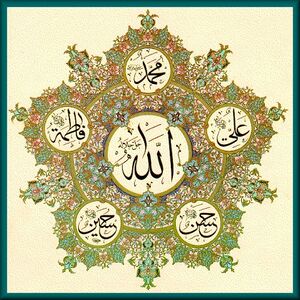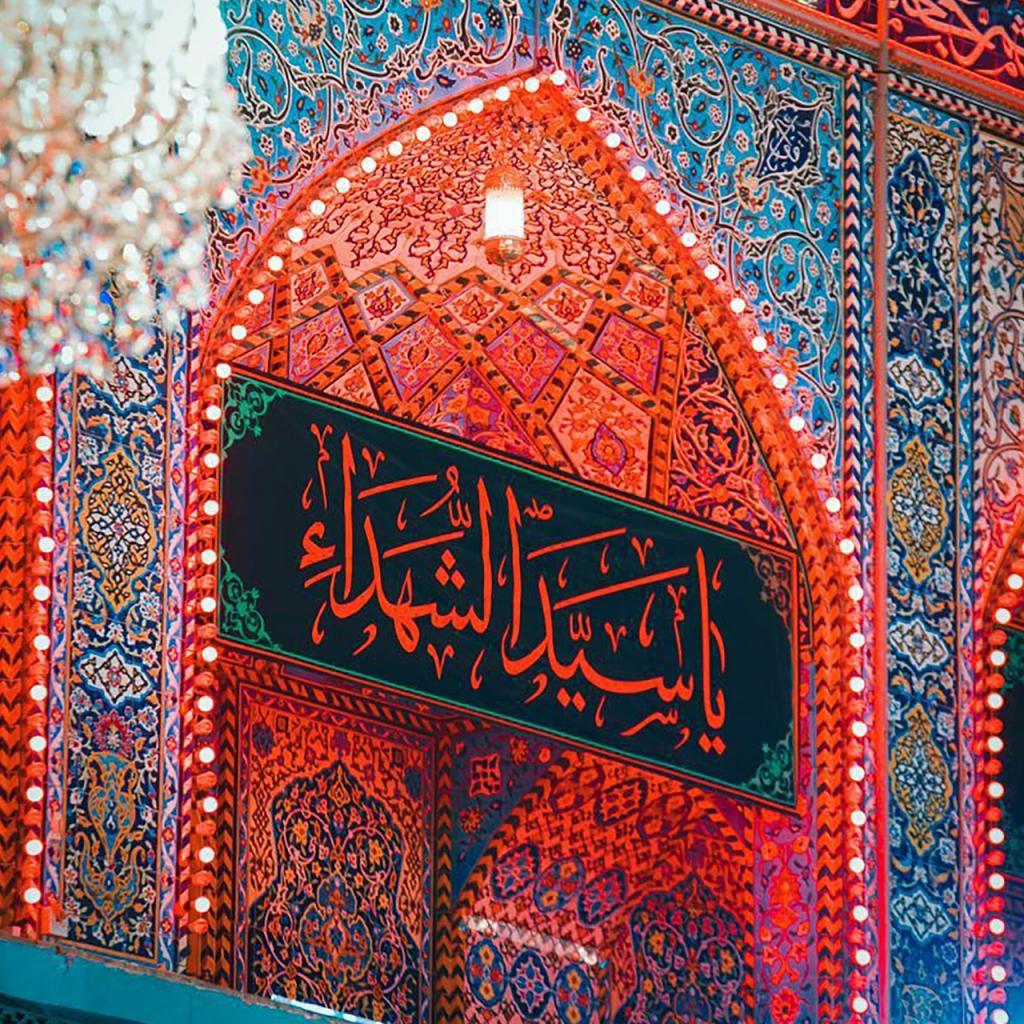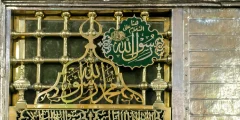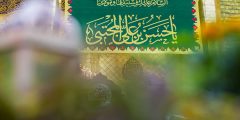The owners of the clothes, It is an address given to Prophet Muhammad (S) andAli bin Abi Talib وFatema وAl Hassan وELHussein (peace on them). And he brought them together The most honorable Messenger (PBUH) under one cloak when the verse of purification was revealed. These are also called titles The five wearers, AndAl Abaya, AndThe five ghosts. This incident represents one of their prominent virtues, and indicates that “they are the best of people” and “the most honorable of creation to God and the most honorable in His sight.”
The credibility of the owners of the clothing
The sources of both the Shiite and Sunni factions transmitted many narrations that indicate the true origins of the wearers, namely: the Messenger (PBUH), Ali, Fatima, Al-Hasan, and Al-Hussein (PBUH). It was narrated on the authority of Umm Salamah that she wanted to go under the cloak, but he (may God bless him and grant him peace) did not give her permission and said: You are doing well.
It was narrated on the authority of Imam al-Sadiq (peace be upon him): The wearers who were the most honorable of creation before God Almighty were five: the Prophet (S) andCommander of the Faithful, AndFatema وAl Hassan وELHussein (peace on them). It was mentioned in the visit of the Commander of the Faithful (peace be upon him): Peace be upon you, O fifth person of the cloak. There is also a visit to Imam Hussein (peace be upon him), where he was addressed with this title: “The fifth of the people of clothing.”
When the verse of purification was revealed, the Prophet (PBUH) restricted its meanings to these five only.
The scholar Al-Hilli has stated the frequent revelation of the verse of purification regarding these five, so no one doubts that except the stubborn. Hence the title “The owners of the clothing» In them, whenever he mentioned, the mind turned to them (peace be upon him), and from here the commentators and researchers were content to mention the title without mentioning the authenticators, as was stated in the reason for the revelation of the Almighty’s saying. ﴿They eat food for the love of it﴾ Al-Allamah Al-Majlisi stated that the commentators and hadith scholars unanimously agreed that it was revealed regarding the people of clothing.
Read also:Al-BaqiThe virtues of those who wear clothing in the Holy Quran
The term “five” became famous in Islamic heritage based on what was mentioned regarding the reason for the revelation of the verse of purification, where Shiite and Sunni commentators unanimously agreed that the verse was revealed about five people: The most honorable Prophet (s) and on (PBUH) And Fatima (PBUH) And the good (PBUH) And Hussein (PBUH), and that the Messenger (PBUH) confined them to a special robe and did not associate anyone else with them, saying: Oh God! These are the people of my household and my own. I will remove impurity from them and purify them with a thorough purification.
Among the verses that indicate the virtue of these five are:
- The Mubahala verse, God Almighty made the soul of His Messenger (peace be upon him) and the soul of Ali (peace be upon him) one, and restricted the women to Fatima (peace be upon him) and the sons to Al-Hassan (peace be upon him) and Al-Hussein (peace be upon him). What is meant by them is not the sons and wives of Muslims, but rather the sons and daughter of the Noble Prophet (peace be upon him).
- Verses 5 to 22 of Surat Al-Dahr (Al-Insan), which the commentators unanimously agreed was revealed against the Commander of the Faithful (peace be upon him), Fatima (peace be upon him), Al-Hasan (peace be upon him), and Al-Hussein (peace be upon him) when they gave in charity their breakfast food for three days to the poor, the orphan, and the prisoner, so the verses were revealed praising their position and praising them. How loyal they are to God Almighty.
- The verse of affection in which the commentators from both groups agreed that what is meant by the relatives is the family of the Prophet, represented by Ali (peace be upon him), Fatima (peace be upon him), Al-Hasan (peace be upon him), and Al-Hussein (peace be upon him), and whose affection was made a reward for the message of the most honorable Prophet (peace be upon him).
- Verses 19 to 22 of Surat Al-Rahman. It was narrated on the authority of Imam Al-Sadiq (peace be upon him) that he said regarding the interpretation of this verse: ﴿Marj Al-Bahrain meet﴾“Ali and Fatima (peace be upon her) are two deep seas, neither of them oppresses the other. ﴿From them emerge pearls and coral.﴾ He said: Al-Hassan and Al-Hussein (peace be upon him). This meaning was conveyed from some of the companions of the Messenger (PBUH). Interpretation of Al-Durr Al-ManthurThe scholar Al-Tabarsi transmitted it in Majma’ al-Bayan, with a slight difference. From here we know that the Holy Qur’an has multiple meanings, and that one verse can have multiple meanings or even dozens of meanings. The final interpretation is from the essence of the Qur’an, and does not contradict its apparent meanings.
- God Almighty said in verse 37 of Surah Al-Baqarah ﴿Then Adam received words from his Lord...﴾Where the public and private groups narrated in their interpretation of the blessed verse that God Almighty taught Adam (peace be upon him) to supplicate to the five good lights in order for him to repent.; In some narrations there is a reference to the derivation of the names (Muhammad, Ali, Fatima, Hassan and Hussein) from the names of God Almighty, which are: (Mahmoud and Hamid, Ali and Ali and Ali, Fatir and Fatim, Mohsin and Dhu Al-Ihsan and the One with the Most Beautiful Names).
It also included an explanation and interpretation of the aforementioned verse and the verse of affliction ﴿And when his Lord tested Abraham with words, and he fulfilled them﴾ By interpreting the five words mentioned in the previous verse, and his saying ﴿So he completed them﴾ The nine imams from the descendants of Hussein (peace be upon him). In addition to this are many virtues and virtues mentioned in the Holy Qur’an for the five wearers.
Read also:The story of Zamzam waterAmong them is what came from the interpretation of the Almighty in the Almighty’s saying ﴿Were you arrogant or were you one of the arrogant?﴾ With the good five.
There are other verses that the narrations of both groups interpreted as the five (peace be upon them), including: An-Nisa: 69; Ibrahim: 24; Bees: 43; Taha: 132; Al-Furqan: 74; Al-Dhariyat: 27; Phase: 21; The cram:
The five virtues in hadiths
In addition to the verses that referred to the five virtues, there are many narrations that address this, narrated by Muslims in all their sects, and due to their large number, hadith books devoted special sections to them under the title of the five virtues and their virtues.
In some of them, the name Gabriel (peace be upon him) was added to them, “and Gabriel is our sixth.”
Anyone who follows the sources of hadith and narration will see in many of the sermons and dialogues of Ahl al-Bayt (peace be upon him) what indicates their pride in belonging to these five people at times and using that term as persuasive material to prove the integrity of their writing and the originality of their thought at other times.
The priority of the five over other imams
It is established that these five (peace be upon them) were superior to the rest of the infallible ones (peace be upon them) from those pure offspring, and this is indicated by many pieces of evidence, including the common virtues specific to the five good ones, in addition to the testimony of Imam Hussein (PBUH) in the year 61 AH, which is considered the seal of the good five; In addition to the supplications and visits that considered his martyrdom and death, peace be upon him, to be equivalent to the death of five people combined, and his calamity was considered the greatest of the calamities and calamities that befell the People of the House (peace be upon him). Note that these titles were given to the Commander of the Faithful (peace be upon him) out of respect for him and his status.
Read also:The story of Prophet JobIt is worth noting here that the five good ones also vary in virtue, as is confirmed by the narrations issued by the infallibles (peace be upon them), where they made The most honorable Prophet (PBUH) is at the top of virtue, ahead of the other four and following him Commander of the Faithful (A) is superior in credit to Fatima Alzahraa (P) andAl Hassan(P) andELHussein (PBUH). Words differed as to whether Fatima (peace be upon her) was preferred over Al-Hussein or vice versa.
Footnotes
- Al-Kulayni, Al-Kafi, vol. 2, p. 8.
- Muslim bin Hajjaj, Sahih Muslim, vol. 15, p. 190, Al-Sawa’iq Al-Muharraqah, Cairo Library, page 143.
- Ibn Babawayh, Illal al-Shara’i’, vol. 1, p. 733
- Ibn Tawus, Iqbal al-A’mal, vol. 2, p. 572, and Al-Majlisi, Bihar al-Anwar, vol. 97, pp. 302 and 373.
- Al-Majlisi, Bihar Al-Anwar, vol. 98, p. 318
- Al-Hurr Al-Amili, Proof of Guidance through Texts and Miracles, vol. 2, p. 201.
- Allama Al-Hilli, Approach to Truth and Revealing Truth, p. 230.
- Man, verse 8.
- Al-Majlisi, Bihar Al-Anwar, vol. 35, p. 256.
- Parties: 33.
- Al Imran: 61.
- Al-Shura: 23.
- Al-Shushtari, vol. 3, pp. 274-279, vol. 9, pp. 107-109.
- Al Majlisi, vol. 24, pp. 97-99, vol. 37, pp. 64, 73, 96.
- Al-Suyuti; Al-Tabarsi, the end of the verse.
- Makarem Al-Shirazi, vol. 17, p. 395.
- Al-Shushtari, vol. 3, pp. 76-80, vol. 5, pp. 11, vol. 9, pp. 102-105.
- Al Majlisi, vol. 26, pp. 323-328, 333.
- Hosseini Firouzabadi, vol. 1, p. 205.
- Al-Amini, vol. 7, pp. 300-301.
- Al-Shushtari, vol. 5, p. 4.
- Al-Majlisi, vol. 15, pp. 9, 14-15, vol. 25, p. 6, vol. 26, pp. 327-328, vol. 37, pp. 47, 62-63.
- Al-Amini, vol. 2, pp. 300-301.
- Al-Baqarah: 124.
- For an example, see Al-Bahrani; And Al-Tabarsi, at the end of the aforementioned verse.
- Al-Shushtari, vol. 3, p. 79, vol. 5, pp. 262-265, vol. 7, pp. 180-183, vol. 18, pp. 344-347.
- Al-Majlisi, vol. 25, pp. 2-3, 6, 16-17, vol. 26, pp. 273, 311-312, 323-327, 343.
- Al-Husseini Al-Fayrouzabadi, vol. 1, p. 207; Al-Amini, vol. 2, pp. 300-301; Al-Qandouzi, vol. 1, p. 290.
- P. 75.
- Al-Bahrani, the end of the verse.
- Al-Majlisi, vol. 25, p. 2, vol. 26, pp. 346-347.
- See Al-Shushtari, vol. 3, pp. 482-483, 542, 560, vol. 14, pp. 375, 389-391, 542, 550, 591-593, 637, 682.
- Al-Shushtari, vol. 5, pp. 3-4, 11-22, 45-46, vol. 18, p. 384 et seq.
- Al Majlisi, vol. 37, pp. 35-107.
- Al-Qandouzi, vol. 1, p. 323.
- Al-Majlisi, vol. 42, p. 63, vol. 43, p. 49; To learn about the virtue of the five, peace be upon them, of the wearers of the robe, their love, and their earthly and hereafter status, see also: Al-Majlisi, vol. 37, pp. 36-37, 47, 64-65, 75, 78, 84-85; Al-Husseini Al-Fayrouzabadi, vol. 1, p. 300, vol. 2, p. 78, vol. 3, pp. 133, 139-141; Al-Amini, vol. 2, pp. 300-301; Al-Shushtari, vol. 5, pp. 20, 53, 90, vol. 18, pp. 348-355; Interpretation of the verse on affection in the book of Al-Zamakhshari; Al-Qanduzi, vol. 2, pp. 68, 297.
- See Al-Shushtari, vol. 5, pp. 28-29, 31-32, 39.
- Al-Majlisi, vol. 33, p. 184, vol. 37, pp. 48, 66, vol. 45, p. 138.
- Al-Amini, vol. 1, pp. 160, 209.
- Al-Majlisi, vol. 45, p. 250, vol. 98, pp. 179, 196, 235, 313, 318, 360.
- Al-Majlisi, vol. 44, pp. 269-270, vol. 45, pp. 2, 88.
- See Al-Majlisi, vol. 65, p. 130, vol. 97, pp. 205, 302, 373.
- Al-Majlisi, vol. 26, p. 272, vol. 37, pp. 75, 87, vol. 39, pp. 90-92.
- See Aqa Buzurg al-Tehrani, vol. 4, p. 359.
- Mirza al-Qummi, vol. 2, p. 785.
- Al-Majlisi, vol. 43, p. 264, vol. 45, p. 3.
Note
- It was mentioned in the source (which), but it is more correct (who) Maybe there was something wrong.
References
- ↑
- The Holy Quran.
- Al-Hilali, Salim bin Qais, Book of Salim bin Qais Al-Hilali, corrected by: Ansari Zanjani, Khoeini Muhammad, Al-Hadi, Qom, 1405 AH.
- Ibn Babawayh, Muhammad bin Ali, Illal al-Shari’a, translated by Dhaqi al-Tahrani, Publications of the Believers, Qom, 1380 AH.
- Ibn Tawus, Ali bin Musa, Iqbal al-Amal, Tehran, Dar al-Kutub al-Islamiyyah, 1409 AH.
- Allama Al-Hilli, Hassan bin Yusuf bin Mutahhar, The Approach to Truth and Revealing Honesty, Beirut, Dar Al-Kitab Al-Lubani, 1982 AD.
- Al-Majlisi, Muhammad Baqir bin Muhammad Taqi, Bihar Al-Anwar, Beirut, Arab Heritage Revival House, 1403 AH.
- Muslim bin Al-Hajjaj, Sahih Muslim, Beirut, Dar Al-Ma’rifa, 1423 AH / 2003 AD.
- Al-Hurr Al-Amili, Muhammad bin Hassan, Proof of Guidance through Texts and Miracles, Beirut, Al-Alami Foundation, Beirut 1425 AH.
- Ibn Hajar, Ahmed bin Muhammad Ibn Ali Ibn Hajar Al-Haythami, Al-Sawa’iq Al-Muharraqah, Egypt, Cairo Library, 1385 AH.









